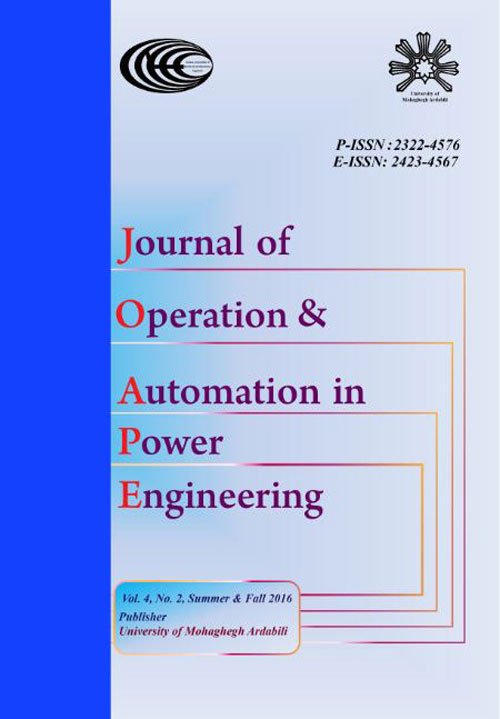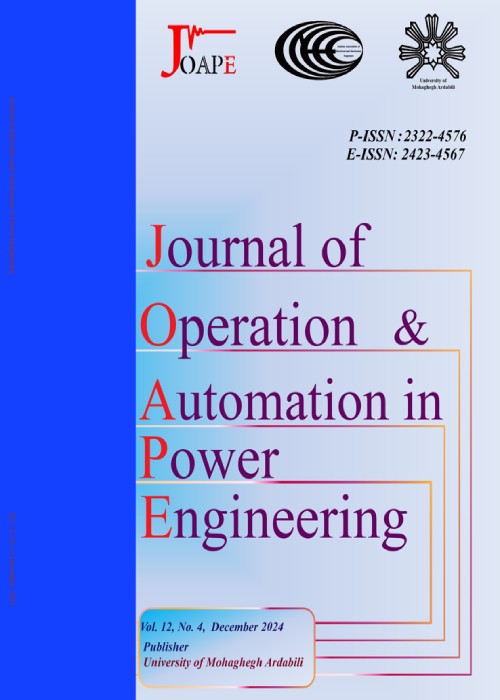فهرست مطالب

Journal of Operation and Automation in Power Engineering
Volume:4 Issue: 2, Summer - Autumn 2016
- تاریخ انتشار: 1395/10/09
- تعداد عناوین: 7
-
-
Pages 93-103In this paper, a combination of simulated annealing (SA) and intelligent water drops (IWD) algorithm is used to solve the nonlinear/complex problem of simultaneous reconfiguration with optimal allocation (size and location) of wind turbine (WT) as a distributed generation (DG) and dynamic voltage restorer (DVR) as a distributed flexible AC transmission systems (DFACT) unit in a distribution system. The objectives of this research are to minimize active power loss, minimize operational cost, improve voltage stability, and increase the load balancing of the system. For evaluation purposes, the proposed algorithm is evaluated using the Tai-Power 11.4-kV real distribution network. The impacts of the optimal placement of the WT, DVR, and WT with DVR units are separately evaluated. The results are compared in terms of statistical indicators. By comparing all the testing scenarios, it is observed that the multi-objective optimization evolutionary algorithm is more beneficial than its single-objective optimization counterpart. Also, the obtained results show that the proposed SAIWD method outperforms the IWD method and other intelligent search algorithms such as genetic algorithm or particle swarm optimization.Keywords: Distribution system, Dynamic voltage restorer, Intelligent water drops, Reconfiguration, Simulated annealing, Wind turbine
-
Pages 104-116Increasing the penetration of variable wind generation in power systems has created some new challenges in the power system operation. In such a situation, the inclusion of flexible resources which have the potential of facilitating wind power integration is necessary. Demand response (DR) programs and emerging utility-scale energy storages (ESs) are known as two powerful flexible tools that can improve large-scale integration of intermittent wind power from technical and economic aspects. Under this perspective, this paper proposes a multi objective stochastic framework that schedules conventional generation units, bulk ESs, and DR resources simultaneously with the application to wind integration. The proposed formulation is a sophisticated problem which coordinates supply-side and demand-side resources in energy and up/down spinning reserve markets so that the cost, emission, and multi objective functions are minimized separately. In order to determine the most efficient DR program which can potentially coordinate with bulk ESs in the system with a significant amount of wind power, a comprehensive DR programs portfolio including time- and incentive-based programs is designed. Afterwards, strategy success index (SSI) is employed to prioritize DR programs from independent system operator (ISO) perspective. The IEEE-RTS is used to reveal the effectiveness of the proposed method.Keywords: Bulk energy storages, Demand response programs, Electricity market, Wind power generation
-
Pages 117-131In this paper, a new structure for buck-boost Z-source converter based on Z-H topology is proposed. The proposed converter consists of two LC networks similar to the conventional Z-source and Z-H converters. One of the characteristics of the proposed structure is that, without any changing in its power circuit, it can be used in different conversions such as dc/dc, dc/ac and ac/ac. This unique characteristic of the proposed structure is similar to matrix converters. To use this structure in different conversions just control system should be changed. Other main advantages of the proposed converter are simpler topology, step-up and step-down capabilities and low ripple in voltage and current waveforms. Due to capabilities of the proposed converter mentioned above, it can be used in applications such as connect renewable energy sources to the grid, speed control of induction machines, electric vehicles and etc. In this paper, a complete analysis of the proposed converter in dc/dc conversion with details and mathematical equations is presented. Moreover, for the proposed topology, the ripple of inductors and capacitors is given. A suitable control method is presented, too. Also, the power losses and efficiency of the proposed converter are calculated. The correctness operation of the proposed converter is reconfirmed by the experimental results.Keywords: Buck, boost dc, dc converter, LC network, Shoot, through (ST) state, Z, H converter, Z, source inverter
-
Pages 132-142This paper combines quasi-Z-source into a typical five-level inverter, which includes two dc voltage sources, two quasi-Z-sources and five switching devices. In this structure, the output voltage amplitude is not limited to dc voltage source and it can be increased by quasi-Z-source. Besides, due to nature of Z-source families, this new structure is reliable and higher efficiency. Also, in this inverter, two quasi-Z-networks can be controlled independently. This paper also proposes new switching algorithms for proposed five-level dual quasi-Z-Source inverter based on pulse width modulation (PWM) and selective harmonic elimination method (SHEM) algorithms .The performance of proposed inverter and switching algorithm are validated with simulation results using MATLAB/SIMULINK software and experimental results based PCI-1716 data acquisition system.Keywords: Two inputs five, level inverter, quasi, Z, source, PWM, SHEM, shoot, through implementation
-
Pages 143-152In this paper, the stand-alone photovoltaic system for cathodic protection of underground pipelines is presented. The proposed system offers continuous and automatic adjustment of the applied voltage so that the buried pipelines receive the exact current. A modified perturb and observe (P&O) algorithm for maximum power point tracking (MPPT) is used to improve dynamic and steady state performance. The battery stores excess energy generated by PV array and supplies the load when there is a shortage of the photo voltaic (PV) power. To extend the battery lifetime and the system efficiency, the battery is connected to the DC link by a ZVS bidirectional Buck-Boost converter. A classic PI controller regulates output voltage by controlling the duty cycle of the converter. The supervisor controls the converter to operate system in suitable modes based on the state of charge (SOC) of the battery and DC link voltage. The simulation verified that the output voltage obtains the constant voltage under any climatic conditions.Keywords: DC, DC converter, Photovoltaic, Maximum power point tracking, Anode, bed, Cathodic protection
-
Pages 153-164Utilizing capacitor banks is very conventional in distribution network in order for local compensation of reactive power. This will be more important considering uncertainties including wind generation and loads uncertainty. Harmonics and non-linear loads are other challenges in power system which complicates the capacitor placement problem. Thus, uncertainty and network harmonics have been considered in this paper, simultaneously. Capacitor placement has been proposed as a probabilistic harmonic problem with different objectives and technical constraints in the capacitor placement problem. Minimizing power and energy loss and capacitor prices are considered as objectives. Particle Swarm Optimization (PSO) and Differential Evolution (DE) algorithms have been used to solve the optimization problem. Loads are subjected to uncertainty with normal probabilistic distribution function (PDF). Auto Regressive and Moving Average (ARMA) time series and two point estimate method have also been utilized to simulate the wind speed and to perform the probabilistic load flow, respectively. Finally, the proposed method has been implemented on standard distorted test cases in different scenarios. Monte Carlo Simulation (MCS) has also been used to verify the probabilistic harmonic power flow. Simulation results demonstrate the efficiency of the proposed method.Keywords: Uncertainty, Two point estimate method, Probabilistic harmonic power flow, PSO, DEA
-
Pages 165-174This paper presents a new and useful methodology for simultaneous allocation of sectionalizer switches and distributed energy resources (DERs) considering both reliability and supply security aspects. The proposed algorithm defines the proper locations of sectionalizer switching devices in radial distribution networks considering the effect of DER units in the presented cost function and other optimization constraints such as providing the maximum number of costumers to be supplied by DER units in islanded distribution systems after possible outages. In this paper, the main goal of cost function is to minimize the total cost of expected energy not supplied (EENS) with regard to impacts of load priority and optimum load shedding in the both grid connected and islanding states after possible outages. The proposed method is simulated and tested on a case study system in both cases of with DER and non DER situations. Also, this paper evaluates the number and amount of DER, switch and different DER penetration percentage effects in cost function value. For solving of mentioned problem, this paper uses a new and strong method based on imperialist competitive algorithm (ICA). Simulation and numerical results show the effectiveness of the proposed algorithm for placement of switch and DER units in the radial distribution network simultaneously.Keywords: Optimal switch placement, Optimal DER placement, Reliability assessment, Imperialist competitive algorithm, Supply security aspects


